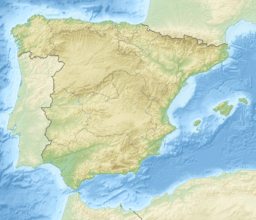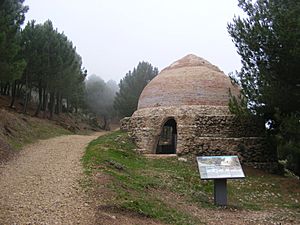Sierra Espuña facts for kids
Quick facts for kids Sierra Espuña |
|
|---|---|
 |
|
| Highest point | |
| Elevation | 1,583 m (5,194 ft) |
| Geography | |
| Location | Bajo Guadalentín Region of Murcia |
| Parent range | Penibaetic System, Eastern zone |
| Geology | |
| Mountain type | karstic |
The Sierra Espuña is a beautiful mountain range in the Region of Murcia, Spain. It's part of a bigger mountain system called the Penibaetic System. This special area is protected as the Sierra Espuña Regional Park, covering a huge 17,804 hectares (that's about 44,000 acres!) across towns like Alhama de Murcia, Totana, and Mula.
The highest point in the range is also called Espuña, standing tall at 1,583 meters (about 5,194 feet). The very top of this peak is a military zone. It's home to a radar station used by the Spanish Air and Space Force to watch the skies.
A long time ago, by the late 1800s, the Sierra Espuña mountains were in bad shape. Most of their trees were gone, and the area was at risk of becoming a desert. But in 1889, a clever forest engineer named Ricardo Codorníu started a huge project. He worked hard to plant trees all over the mountains again. His amazing work became a famous example for others to follow.
Because of its importance, the area was declared a natural site of national interest in 1931. Later, in 1992, it became a protected Regional Park. It's also a special place for birds and an important natural habitat.
Contents
Exploring Sierra Espuña
There are many cool places to visit and explore in the Sierra Espuña Regional Park.
Ricardo Codorníu Visitors Centre
The Ricardo Codorníu Visitors and Management Centre is named after the engineer who replanted the forests. It's an old mansion right in the middle of the Sierra. Here, you can find information about the park, watch videos in the Projection Room, and see interesting displays in the Exhibition Room.
Huerta Espuña: A Special Garden
Right next to the Visitor Centre is an area called Huerta Espuña. This was the main spot where Ricardo Codorníu planned his reforestation work. He planted the first experimental crops here to see what plants could grow well in this environment. Today, you can still see some of the old orchards. Some are even used for projects to help rare wild plants grow again.
Pozos de Nieve: Ancient Ice Houses
High up in the mountains, you'll find the "Pozos de nieve" (which means "snow wells"). These are like old ice houses that were first built in the late 1500s. People used them to store snow during winter. Then, in the summer, they would turn the snow into ice and send it to hospitals, cities, and towns in the Kingdom of Murcia. These unique ice houses were used until the 1920s!
Collado Bermejo Viewpoint
If you want to see an amazing view of the whole Sierra, head to the Collado Bermejo viewpoint. It's located at 1,201 meters (about 3,940 feet) high and offers one of the best panoramic sights.
Barrancos de Gebas: Unique Ravines
To the east of the main mountains, below the village of Gebas, are the Gebas barrancos (ravines). These ravines formed millions of years ago when the area was a salty lake under the sea. They look very different from the rest of the landscape. The best way to see them is from the Librilla side, where you get a high-up view of the entire area.
Animals and Plants
The Sierra Espuña is full of life!
Plant Life
Large parts of the Sierra Espuña are covered with tall pine trees. Along the riverbeds and in the ravines, you can find other trees like oleanders, poplars, elms, birches, and willows.
Animal Life
The Sierra is home to many different animals. There are about 120 types of birds, including eagles, jays, hawks, sparrowhawks, eagle owls, and larks. You might also spot wild boar and squirrels. Interestingly, the Barbary sheep was brought to the Sierra Espuña in the 1970s.
Climate
The weather in Sierra Espuña is a bit different from the rest of the Murcia region. It gets about 200 millimeters (almost 8 inches) more rain each year. Also, the temperature is usually about five degrees Celsius (nine degrees Fahrenheit) cooler than the average for the region.
See also
 In Spanish: Sierra Espuña para niños
In Spanish: Sierra Espuña para niños



